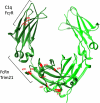Coming together at the hinges: Therapeutic prospects of IgG3
- PMID: 33602056
- PMCID: PMC7899677
- DOI: 10.1080/19420862.2021.1882028
Coming together at the hinges: Therapeutic prospects of IgG3
Abstract
The human IgG3 subclass is conspicuously absent among the formats for approved monoclonal antibody therapies and Fc fusion protein biologics. Concern about the potential for rapid degradation, reduced plasma half-life, and increased immunogenicity due to marked variation in allotypes has apparently outweighed the potential advantages of IgG3, which include high affinity for activating Fcγ receptors, effective complement fixation, and a long hinge that appears better suited for low abundance targets. This review aims to highlight distinguishing features of IgG3 and to explore its functional role in the immune response. We present studies of natural immunity and recombinant antibody therapies that elucidate key contributions of IgG3 and discuss historical roadblocks that no longer remain clearly relevant. Collectively, this body of evidence motivates thoughtful reconsideration of the clinical advancement of this distinctive antibody subclass for treatment of human diseases. Abbreviations: ADCC - Antibody-Dependent Cell-mediated CytotoxicityADE - Antibody-dependent enhancementAID - Activation-Induced Cytidine DeaminaseCH - Constant HeavyCHF - Complement factor HCSR - Class Switch RecombinationEM - Electron MicroscopyFab - Fragment, antigen bindingFc - Fragment, crystallizableFcRn - Neonatal Fc ReceptorFcγR - Fc gamma ReceptorHIV - Human Immunodeficiency VirusIg - ImmunoglobulinIgH - Immunoglobulin Heavy chain geneNHP - Non-Human Primate.
Keywords: IgG3; antibody; hinge; immunoglobulin subclass; infectious disease; vaccine.
Figures



References
Publication types
MeSH terms
Substances
Grants and funding
LinkOut - more resources
Full Text Sources
Other Literature Sources
Medical
